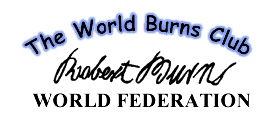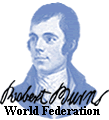


 |
 |
 |
It has been quite
difficult to discover the private man
behind the Burns collector but we know that John was
born on 24th September 1852 somewhere in Scotland.
Early in life he moved to London where he worked in the seed business as a clerk, a commercial traveller and eventually as a manager for Carters Seeds. We know where John lived in Hammersmith and that he travelled regularly between England and Scotland, probably on business. He was a Freemason of a Scottish lodge.
He befriended Craibe Angus another important Burns collector of the time and was inspired to create his own collection. He collected around 1,500 books, 80 pictures, busts, souvenirs and many commemorative pieces.
Towards the end of his life, Murison wanted to make sure that his collection was not split up after his death so he decided to sell it on condition that it would remain together. In June 1921 Sir Alexander Gibb, another Burns enthusiast, bought the collection and presented it to Dunfermline.
Murison died
on 26th November 1921 in his 69th year and was buried in the family grave
at Paddington Cemetery. The tombstone no longer exists but notes about it
showed that he had been married twice. His first wife Jane died in 1891, and
his second wife Alice (nee Sibbald) in 1915. He was survived by a daughter
Ethel Louise Murison and a son, Major Murison. The Major was serving in the
Canadian Artillery and didn't go to the funeral.
SIR ALEXANDER GIBB
(1872-1958)
Alexander Gibb was born on 12th February 1872 at Broughty Ferry and was educated at Rugby and University College, London. He joined his father's engineering business as managing director of Easton, Gibb and Son in 1900. He was involved in great bridge and dock building projects such as the King Edward VII Bridge at Kew in London, the Kincardine Bridge, the Mersey Docks and docks in Sydney, Australia.
His outstanding achievement was his vital work on the construction of Rosyth Dockyard and its completion in time to be of great value to the British Fleet during the First World War.
Gibb was president of the Dunfermline United Burns Club and vice president of the Burns Federation. When he heard that John Murison was selling his Burns collection in 1921 he bought it and presented it to Dunfermline as a mark of his gratitude for kindness shown to him whilst living in the area.
He was a prominent Freemason. Sir Alexander also took a keen interest in the Pittencrieff Old Boys Club of which he was an honorary member. Each year he presented the members with tobacco and their wives with sweets. He was also honorary president of the Pitreavie Golf Club and a supporter of the local Masonic Bowling Association.
Sir Alexander
died at his home "The Anchorage" at Hartley Wintney near Reading
on 21st January 1958,
aged 85.
ROBERT BURNS
(1759-1796)
Robert Burns was born on 25th January 1759 in a cottage at Alloway, Ayrshire. He was the eldest son of William Burns, a small farmer. After his father's death in 1784 he and his brother Gilbert leased the farm of Mossgiel, near Mauchline. Whilst struggling to make a living from the farm he wrote many of the poems which were included in the Kilmarnock edition, published in 1786. This book caused an immediate sensation in Ayrshire, then in Edinburgh, then in London and around the world.
Burns married Jean Armour in 1788 and they settled at Ellisland Farm near Dumfries. Problems with the farm led to Burns taking a job as an exciseman or customs officer which paid him a regular salary. Burns was a Freemason.
He had had health problems since his teens, suffering from bouts of rheumatic fever and depression. Early in 1796 whilst returning home late one evening from the Globe Tavern he fell down in the snow and slept for several hours in the open air. After this his health seemed to go downhill until his death on 21st July 1796 at the age of 37.
"He is as much a Scottish hero as William Wallace or Robert Bruce" and has become a national icon. To see why you have to read the poems and the songs.
Look out for these works in this exhibition:
Tam O'Shanter
John Anderson my Jo
The Twa Dogs A Red, Red Rose
Highland Mary The Jolly Beggars
Willie Brewd a Peck o' Maut To a Mouse
To a Mountain Daisy The Banks o' Doon